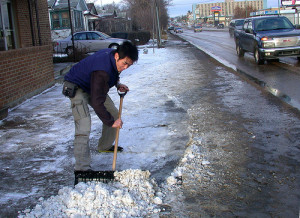 Snow and ice removal is an inevitable fact of winter. For many people, the basics such as the driveway and walkways can be easily covered—but even the paths less travelled and other areas of the home need to be taken care of.
Snow and ice removal is an inevitable fact of winter. For many people, the basics such as the driveway and walkways can be easily covered—but even the paths less travelled and other areas of the home need to be taken care of.
Last week’s big snow storm has come and gone, but there’s sure to be more snow and ice this winter. Proper snow and ice removal is important not only to ensure the safety of your guests and family, but the state of your home as well.
Here are a few tips about proper snow and ice removal this winter:
Addressing snow build-up
While the snow on the roof of your home makes for a picturesque winter look, too much snow can actually end up causing problems for you and your home. Here are a few things you need to look for:
Gutter damage. Gutter damage can end up being a very serious issue if not taken care of. Over time, snow will melt and refreeze in your gutters. This buildup puts an unnecessary amount of stress on the gutters, which can pull them away from the house and potentially rip them completely away from the home. Not only can this cost quite a bit of money to replace, but could potentially injure anyone who happens to be underneath or nearby.
Ice dams/water damage. As if that weren’t bad enough, gutter damage can also create ice dams. Ice dams occur when ice builds up around the edge of your roof, typically in and around the gutter. As snow begins to melt from the top of your roof, water will run into these dams and pool behind them and will eventually find its way under the roof sheathing or worse, into the ceiling or walls of your home. Proper insulation and effective gutters are important to preventing this problem.
So how do you prevent this from occurring? Going up on your roof is one (dangerous) option, but the better and safer option is to invest in a snow rake—essentially, a wide plank attached to a long pole, designed to scrape snow off your roof.
Before using the rake, be sure to look around your roof and avoid trying to pull too much snow off in one go. It is also a good idea to direct the snow away from you in case any large chunks of hard snow or ice come tumbling down.
When that snow does melt and roll into your gutter, it is important that there is a clear path to the downspout and away from your house. Leaves and debris will slow or stop this flow. Omaha Door and Window can install gutter protection that allows the water to flow into the gutter while stopping leaves from entering.
Other things to consider
Snowblower safety. Snowblowers are a wonderful invention, but can end up causing very serious injury if not used properly. First things first: if your snowblower is gas-powered, be sure to start it outside and not in the garage or shed in order to prevent carbon monoxide poisoning. Avoid wearing loose fitting clothing or anything such as a scarf that may get caught in the blower.
Never, under any circumstances, try to unclog a snow blower when it’s on. Before it snows, you’ll also want to clear your driveway and sidewalks of newspapers, branches, and other debris which can clog your snowblower or turn into dangerous projectiles when you’re clearing snow.
Wearing the proper shoes. This may seem like a no-brainer, but wearing non-slip shoes with plenty of traction is extremely important when removing snow to prevent head or back injury. If your boots are too slippery, traction aids like Yaktrax act like tire chains for your shoes and give you much more confidence, even on ice. No matter what, work deliberately to avoid injury.
Ice salt. As you probably already know, salt is great for melting ice, but only in moderation. Ice salt is typically made up of calcium chloride, which has quite a few adverse side effects if not used properly, including concrete damage over time. Always be sure to open the container in the open air, as it can be very harmful when breathed in.
Also, please be sure to wear gloves or some sort of protection for your hands since calcium chloride can seriously irritate your skin. It’s generally recommended to avoid using salt or ice melt unless absolutely necessary; shoveling before the snow freezes over goes a long way towards ensuring surfaces stay dry rather than icy.
From this winter through the many winters you’ll endure moving forward, it’s important to take proper precautions when removing snow and ice. These tips should help turn that snow day into a much safer one should you be the person who ends up having to remove all the snow from your driveway and sidewalks.
—
photo credit: Jet Li ‘s work-out secrets revealed via photopin (license)
